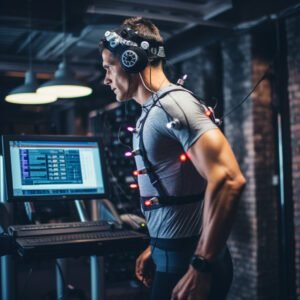
Biohacking for Flexibility: How to Gain Greater Range of Motion and Improve Your Athletic Performance
Introduction
In recent years, biohacking has gained significant attention in the field of health and fitness. The concept of biohacking involves optimizing various aspects of your lifestyle, health, and overall well-being using science, technology, and data-driven approaches. One area of focus in biohacking is flexibility, which plays a crucial role in athletic performance and overall physical fitness. In this blog post, we will explore key concepts of biohacking for flexibility and provide practical tips to help you improve your range of motion and maximize your athletic potential.
Key Concepts of Biohacking for Flexibility
Biohacking for flexibility encompasses a variety of aspects, including nutrition, sleep optimization, exercise, stress management, and technology. Let’s delve into each of these concepts in more detail:
Concept 1: Nutrition
Proper nutrition is essential for maintaining flexibility and supporting muscle health. Focus on consuming a balanced diet rich in vitamins, minerals, and antioxidants. Incorporate foods that have anti-inflammatory properties, such as leafy greens, fatty fish, and turmeric. Stay hydrated by drinking an adequate amount of water throughout the day.
Concept 2: Sleep Optimization
Quality sleep is crucial for muscle recovery and flexibility. Optimize your sleep routine by establishing a consistent bedtime, creating a sleep-friendly environment, and minimizing screen time before bed. Consider using sleep tracking devices or apps to monitor your sleep patterns and make improvements accordingly.
Concept 3: Exercise
Regular exercise is key to improving flexibility. Incorporate a combination of stretching, mobility exercises, and strength training into your fitness routine. Stretching exercises like yoga or Pilates can target specific muscle groups and enhance your range of motion. Incorporating exercises that focus on stability and balance can also improve flexibility and reduce the risk of injuries.
Concept 4: Stress Management
Stress can negatively impact flexibility by causing muscle tension and tightness. Incorporate stress management techniques such as meditation, deep breathing exercises, or mindfulness practices into your daily routine. Additionally, regular massages or foam rolling can help release muscle tension and enhance flexibility.
Concept 5: Technology
Utilize technology to aid in your biohacking journey for flexibility. There are various wearable devices available that can track your movement, posture, and range of motion. These devices can provide valuable insights and help you identify areas for improvement.
Practical Biohacking Tips
Implement the following tips into your daily routine to biohack your flexibility:
- Practice dynamic stretching before and after workouts to warm up your muscles and increase their flexibility.
- Incorporate foam rolling or self-myofascial release techniques to release muscle tension and improve flexibility.
- Incorporate activities like yoga or Pilates into your weekly exercise routine to enhance flexibility and promote a greater range of motion.
- Prioritize quality sleep and establish a consistent sleep routine to support muscle recovery and flexibility.
- Maintain a well-balanced diet that includes anti-inflammatory foods and stay hydrated to promote overall muscle health and flexibility.
- Use wearable devices or apps that track your movement and posture to gain insights into your flexibility and identify areas for improvement.
Remember, consistency is key when it comes to biohacking for flexibility. Incorporate these tips into your routine and gradually increase the intensity and duration of your exercises to see the best results.
Biohacking FAQs
Question 1: Can biohacking alone improve flexibility?
– Answer: Biohacking is a holistic approach that encompasses various aspects of your lifestyle. While biohacking techniques can enhance flexibility, it is essential to combine them with targeted exercises, stretching techniques, and proper nutrition to achieve optimal results.
Question 2: How long does it take to see improvements in flexibility through biohacking?
– Answer: The timeframe for improvements in flexibility can vary depending on several factors, including individual genetics, current flexibility levels, and consistency of biohacking practices. With regular and dedicated efforts, it is possible to start noticing improvements within a few weeks to a couple of months.
Question 3: Can technology devices accurately measure flexibility?
– Answer: While technology devices can provide useful data on movement, range of motion, and posture, they may not offer precise measurements of flexibility. It is important to use these devices as tools to track progress and identify general trends rather than solely relying on them for precise measurements.
Question 4: Are there any risks involved in biohacking for flexibility?
– Answer: When done correctly and with proper guidance, biohacking for flexibility is generally safe. However, it is important to listen to your body, avoid pushing beyond your limits, and seek guidance from qualified professionals if needed. If you have any underlying medical conditions, it is advisable to consult with your healthcare provider before making any significant changes to your routine.
Question 5: Is biohacking a replacement for traditional exercise and stretching?
– Answer: Biohacking is not a replacement for traditional exercise and stretching but rather a complementary approach. It combines various techniques and strategies to optimize your overall health and fitness. Incorporating biohacking principles alongside traditional exercise and stretching methods can yield better results in terms of flexibility and athletic performance.
Conclusion
Biohacking offers a unique approach to optimize flexibility and enhance athletic performance. By incorporating nutrition, sleep optimization, targeted exercise routines, stress management techniques, and utilizing technology, you can biohack your way to greater range of motion and improved overall health. Remember to approach biohacking for flexibility with patience, consistency, and a balanced lifestyle. Prioritize your well-being and consult with professionals if needed. Start your biohacking journey today and unlock your full potential.
[Disclaimer: The information provided in this article is for informational purposes only and should not be considered as medical advice. Consult with your healthcare provider before making any significant changes to your exercise or fitness routine.]


